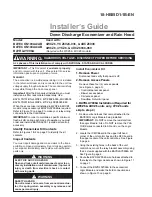
En-6
WARNING
• Install the air conditioner in a location which can withstand
a load do at least five times the weight of the main unit and
which will not amplify sound or vibration. If the installation
location is not strong enough, the indoor unit may fall and
cause injuries.
• If the job is done with the panel frame only, there is a risk that
the unit will come loose. Please take care.
• When fastening the hangers, make the bolt positions uniform.
• Perform final tightening by tightening the double nut firmly.
The product may fall if not installed properly.
• Using a level, or vinyl hose filled with water, fine adjust so
that the body is level.
4.
PIPE INSTALLATION
CAUTION
• Be more careful that foreign matter (oil, water, etc.) does
not enter the piping than with refrigerant R410A models.
Also, when storing the piping, securely seal the openings by
pinching, taping, etc.
• While welding the pipes, be sure to blow dry nitrogen gas
through them.
4.1. Selecting the pipe material
CAUTION
•
Do not use existing pipes.
•
Use pipes that have clean external and internal sides without
any contamination which may cause trouble during use,
such as sulfur, oxide, dust, cutting waste, oil, or water.
•
It is necessary to use seamless copper pipes.
Material : Phosphor deoxidized seamless copper pipes
It is desirable that the amount of residual oil is less than
40 mg/10 m.
• Do not use copper pipes that have a collapsed, deformed,
or discolored portion (especially on the interior surface).
Otherwise, the expansion valve or capillary tube may
become blocked with contaminants.
•
Improper pipe selection will degrade performance. As an air
conditioner using R410A incurs pressure higher than when
using conventional refrigerant, it is necessary to choose
adequate materials.
•
Thicknesses of copper pipes used with R410A are as
shown in the table.
•
Never use copper pipes thinner than those indicated in the
table even if they are available on the market.
Thicknesses of Annealed Copper Pipes (R410A)
Pipe outside diameter [mm (in.)]
Thickness [mm]
6.35 (1/4)
0.80
9.52 (3/8)
0.80
12.70 (1/2)
0.80
15.88 (5/8)
1.00
19.05 (3/4)
1.20
4.2. Pipe requirement
CAUTION
• Refer to the Installation Manual of the outdoor unit for
description of the length of connecting pipe or for difference
of its elevation.
• Use pipe with water-resistant heat insulation.
CAUTION
• Install heat insulation around both the gas and liquid pipes.
Failure to do so may cause water leaks.
Use heat insulation with heat resistance above 120 °C.
(Reverse cycle model only)
In addition, if the humidity level at the installation location
of the refrigerant piping is expected to exceed 70 %, install
heat insulation around the refrigerant piping. If the expected
humidity level is 70-80 %, use heat insulation that is 15 mm
or thicker and if the expected humidity exceeds 80 %, use
heat insulation that is 20 mm or thicker. If heat insulation
is used that is not as thick as specified, condensation may
form on the surface of the insulation. In addition, use heat
insulation with heat conductivity of 0.045 W/(m·K) or less (at
20 °C).
4.3. Flare connection (pipe connection)
WARNING
• Tighten the flare nuts with a torque wrench using the
specified tightening method. Otherwise, the flare nuts could
break after a prolonged period, causing refrigerant to leak
and generate a hazardous gas if the refrigerant comes into
contact with a flame.
4.3.1. Flaring
•
Use special pipe cutter and flare tool exclusive for R410A.
(1)
Cut the connection pipe to the necessary length with a
pipe cutter.
(2)
Hold the pipe downward so that cuttings will not enter the
pipe and remove any burrs.
(3)
Insert the flare nut (always use the flare nut attached to
the indoor and outdoor units respectively) onto the pipe
and perform the flare processing with a flare tool. Use
the special R410A flare tool, or the conventional flare
tool. Leakage of refrigerant may result if other flare nuts
are used.
(4)
Protect the pipes by pinching them or with tape to
prevent dust, dirt, or water from entering the pipes.
B
Die
A
Pipe
Check if [L] is flared uniformly
and is not cracked or scratched.
L







































